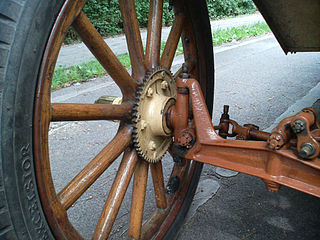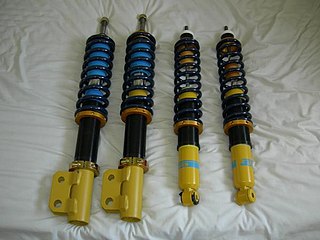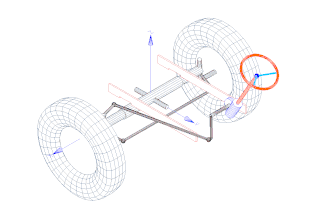
Camber angle is one of the angles made by the wheels of a vehicle; specifically, it is the angle between the vertical axis of a wheel and the vertical axis of the vehicle when viewed from the front or rear. It is used in the creation of steering and suspension. If the top of the wheel is farther out than the bottom, it is called positive camber; if the bottom of the wheel is farther out than the top, it is called negative camber.

The MacPherson strut is a type of automotive suspension system that uses the top of a telescopic damper as the upper steering pivot. It is widely used in the front suspension of modern vehicles. The name comes from American automotive engineer Earle S. MacPherson, who invented and developed the design.

The kingpin is the main pivot in the steering mechanism of a car or other vehicle.

A strut is a structural component commonly found in engineering, aeronautics, architecture and anatomy. Struts generally work by resisting longitudinal compression, but they may also serve in tension.

A multi-link suspension is a type of vehicle suspension with one or more transversal arms. A wider definition can consider any independent suspensions having three control links or more multi-link suspensions. These arms do not have to be of equal length, and may be angled away from their "obvious" direction. It was first introduced in the late 1960s on the Mercedes-Benz C111 and later on their W201 and W124 series.

Suspension is the system of tires, tire air, springs, shock absorbers and linkages that connects a vehicle to its wheels and allows relative motion between the two. Suspension systems must support both road holding/handling and ride quality, which are at odds with each other. The tuning of suspensions involves finding the right compromise. It is important for the suspension to keep the road wheel in contact with the road surface as much as possible, because all the road or ground forces acting on the vehicle do so through the contact patches of the tires. The suspension also protects the vehicle itself and any cargo or luggage from damage and wear. The design of front and rear suspension of a car may be different.

Independent suspension is any automobile suspension system that allows each wheel on the same axle to move vertically independently of the others. This is contrasted with a beam axle or deDion axle system in which the wheels are linked. "Independent" refers to the motion or path of movement of the wheels or suspension. It is common for the left and right sides of the suspension to be connected with anti-roll bars or other such mechanisms. The anti-roll bar ties the left and right suspension spring rates together but does not tie their motion together.

The Chapman strut is a design of independent rear suspension used for light cars, particularly sports and racing cars. It takes its name from, and is best known for its use by, Colin Chapman of Lotus.

A coilover is an automobile suspension device. The name coilover is an abbreviation of "coil over shock absorber".

An anti-roll bar is an automobile suspension part that helps reduce the body roll of a vehicle during fast cornering or over road irregularities. It links opposite front or rear wheels to a torsion spring using short lever arms for anchors. This increases the suspension's roll stiffness—its resistance to roll in turns.

In automotive suspension, a control arm, also known as an A-arm, is a hinged suspension link between the chassis and the suspension upright or hub that carries the wheel. In simple terms, it governs a wheel's vertical travel, allowing it to move up or down when driving over bumps, into potholes, or otherwise reacting to the irregularities of a road surface. Most control arms form the lower link of a suspension. Control arms play a crucial role in the suspension system of a vehicle. They help to keep the wheels aligned and maintain proper tire contact with the road, which is essential for safety and stability.
Torque steer is the unintended influence of engine torque on the steering, especially in front-wheel-drive vehicles. For example, during heavy acceleration, the steering may pull to one side, which may be disturbing to the driver. The effect is manifested either as a tugging sensation in the steering wheel, or a veering of the vehicle from the intended path. Torque steer is directly related to differences in the forces in the contact patches of the left and right drive wheels. The effect becomes more evident when high torques are applied to the drive wheels because of a high overall reduction ratio between the engine and wheels, high engine torque, or some combination of the two. Torque steer is distinct from steering kickback.

In an automobile, ball joints are spherical bearings that connect the control arms to the steering knuckles, and are used on virtually every automobile made. They bionically resemble the ball-and-socket joints found in most tetrapod animals.
A dual ball joint suspension uses a pair of arms, one in tension, one in compression, to replace a wishbone, in a MacPherson or SLA suspension. The outer end of each arm terminates in a ball joint, hence the name.
The scrub radius is the distance in front view between the king pin axis and the center of the contact patch of the wheel, where both would theoretically touch the road. It can be positive, negative or zero.

Bump steer is the term for the tendency of the wheel of a car to steer itself as it moves through the suspension stroke.
Automotive suspension design is an aspect of automotive engineering, concerned with designing the suspension for cars and trucks. Suspension design for other vehicles is similar, though the process may not be as well established.

In automotive suspensions, a suspension link, control link or link is a suspension member, that attaches at only two points. One point being the body or frame of the vehicle and the other point attaching to the knuckle, upright, axle or another link. The link pivots on either a bushing or a ball joint at each attachment point. A link differs from a control arm because it can only control one of the degrees of freedom by itself.
Dual-pivot steering geometry is a geometric arrangement of linkages in the steering of a car designed to reduce or eliminate scrub radius by moving the pivot point of the king pin outboard, in order to improve steering precision and straight line stability.
Pull-rod suspension and push-rod suspension refer to a specialised type of automotive suspension system which is largely based on a double-wishbone system, incorporating elements of the commonly used MacPherson strut.















